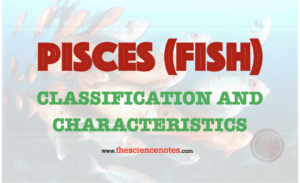Pisces, or fish, are aquatic creatures that possess unique characteristics. They rely on gills for respiration and lack a genuine spine. They inhabit various water environments, including freshwater, marine, and brackish water. Fins play a crucial role in their movement, and these fins can be either paired or unpaired. The study of fish, known as ichthyology, explores their diverse features and behaviors. It is believed that fish originated from sea squirts, primitive organisms resembling fish. Pisces are true jawed vertebrates with specialized systems for respiration, excretion, and circulation. As poikilotherms, they cannot regulate their body temperature. This category encompasses all fish species, including catfish, goldfish, whales, sharks, and jellyfish. Pisces are fascinating organisms with intriguing facts waiting to be discovered.

General Characteristics of Pisces
- Pisces are aquatic organisms found in freshwater, marine, and brackish water environments.
- They have a streamlined body, although some species may have a spindle-shaped or elongated body.
- The body of Pisces is divided into three sections: head, trunk, and tail.
- Pisces swim using their tail, which is usually muscular and assists in propulsion.
- They possess paired and unpaired fins, which serve as appendages and help maintain balance while swimming.
- Pisces have a well-developed lateral line system, which acts as a sensory organ and detects changes in the immediate surroundings.
- The body is covered with thick-seated scales, providing protection to internal organs.
- They have gills for respiration, extracting oxygen from the water.
- Pisces exhibit closed blood circulation, where the blood flows through a closed system of vessels.
- The internal skeleton of Pisces can be composed of either bony or cartilaginous material.
- Pisces are cold-blooded organisms, meaning their body temperature is regulated by the surrounding environment.
- They can be herbivores or carnivores, and their reproductive strategies vary, with some species being oviparous (laying eggs) and others being ovoviviparous (retaining eggs internally until hatching).
- Pisces exhibit sexual dimorphism, with distinct male and female individuals.
- Fertilization in Pisces can occur either externally (outside the body) or internally (inside the body).
- They lack extraembryonic membranes, which are present in some other vertebrate groups.
- They have a well-developed digestive system to process and absorb nutrients from their food.
- The nervous system of Pisces comprises ten pairs of cranial nerves and a brain.
- Pisces encompass a wide range of aquatic vertebrates, including both freshwater and marine species. They can exhibit herbivorous or carnivorous feeding habits.
Hierarchy of Pisces
- Kingdom: Animalia (Animals)
- Phylum: Chordata (Chordates)
- Subphylum: Vertebrata (Vertebrates)
- Class: Pisces or Osteichthyes (Bony Fish) and Chondrichthyes (Cartilaginous Fish)
- Order: Varies based on specific fish species
Classification of Pisces
- Placodermi (Aphstohyoids)
- Extinct fishes, known from fossils
- Bony endoskeleton
- Heterocercal caudal fin
- Examples: Climatius, Bothriolepis
- Chondrichthyes (Elasmobranchi)
- Found in marine environments
- Cartilaginous endoskeleton
- Placoid scales on the skin
- Heterocercal caudal fin
- Examples: Scoliodon, Pristis, Chimaera, Stingray
- Osteichthyes
- Found in marine, freshwater, or brackish water
- Bony endoskeleton
- Various types of scales (placoid, ctenoid, ganoid)
- Autostylic jaw suspension
- Examples: Salmon, Neoceratodus
Additional information:
- Placodermi consists of extinct prehistoric fishes, with a bony endoskeleton and heterocercal caudal fin.
- Chondrichthyes, also known as Elasmobranchi, are cartilaginous fishes found in marine environments. They have placoid scales, heterocercal caudal fin, and a jaw suspension that can be amphistylic or hyostylic.
- Osteichthyes are bony fishes, the largest class of vertebrates, with a bony endoskeleton, autostylic jaw suspension, and various types of scales. They are further divided into subclasses Dipnoi, Crossopterygii, and Actinopterygii.
Comparison between Placodermi, Chondrichthyes, and Osteichthyes
| Parameter | Placodermi | Chondrichthyes | Osteichthyes |
| Habitat | Extinct | Marine environment | Marine, freshwater, brackish water |
| Skeleton | Bony | Cartilaginous | Bony |
| Jaw Suspension | Autodiastylic | Amphistylic | Autostylic |
| Respiratory Organs | Gills | Gills | Gills covered by operculum |
| Caudal Fin | Heterocercal | Heterocercal | Homocercal, heterocercal |
| Reproductive Organs | N/A | Claspers in males | N/A |
| Air Bladder | N/A | Absent | Present |
Learn more about all the classes of vertebrates:
- https://thesciencenotes.com/category/vertebrates/
- https://thesciencenotes.com/category/difference-between/